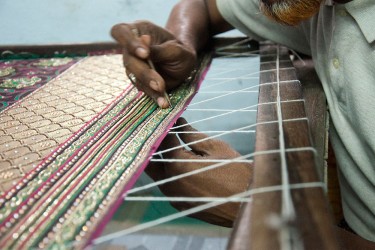Dekho Apna Desh : The beautiful Indian art
Zari : Beauty tied in threads
By - Tribazz
21 April, 2023

Zari art, also known as Zardozi, is a type of embroidery that involves the use of metallic threads, beads, and sequins to create intricate and decorative designs. The art form originated in Persia and was brought to India during the Mughal era. Today, zari art is a popular form of embroidery in many parts of India, particularly in the states of Uttar Pradesh, Rajasthan, and Maharashtra.
History of Zari Art:
Zari art has a long and fascinating history that dates back to the 12th century, when it was first introduced in Persia. The art form quickly spread to other parts of the world, including India, where it gained popularity during the Mughal era.
During this time, zari art was used to embellish the clothing of the wealthy and elite. The embroidery was typically done on silk fabrics using gold and silver threads, and it was often combined with other decorative elements such as pearls, beads, and sequins.
Over time, zari art evolved and began to incorporate different styles and techniques. Today, zari embroidery is done on a variety of fabrics and is used to embellish a wide range of clothing, including sarees, salwar kameez, and lehengas.
Techniques of Zari Art:
There are several techniques used in zari embroidery, each of which produces a unique effect. Some of the most popular techniques include:
Aari work: This technique involves the use of a needle and a hook to create intricate designs on the fabric. Aari work is known for its fine and detailed work and is often used to create intricate floral designs.
Karchobi work: This technique involves the use of metallic threads, beads, and sequins to create a raised texture on the fabric. Karchobi work is often used to create intricate geometric designs.
Zardosi work: This technique involves the use of metallic threads, beads, and sequins to create a more elaborate and decorative design. Zardosi work is often used to embellish bridal wear and other special occasion garments.
Uses of Zari Art:
Zari art is used to embellish a wide range of garments, including sarees, kurtis, salwar kameez, and lehengas. The embroidery is typically done on a variety of fabrics, including silk, cotton, and velvet.
Zari embroidery is also used to create a range of home decor items such as tablecloths, curtains, and cushion covers. The intricate designs and delicate threadwork add a touch of elegance and sophistication to any room.
Zari art has gained popularity not only in India but also across the world. The intricate designs and delicate threadwork have caught the attention of designers and fashion enthusiasts alike, and the embroidery has been featured in many high-profile fashion shows and exhibitions.
In conclusion, zari art is a beautiful and intricate form of embroidery that reflects the rich cultural heritage of India. The technique has been practiced for centuries and continues to evolve and inspire new designs and styles. The use of metallic threads, beads, and sequins in zari embroidery creates a dazzling effect that makes it truly unique and one-of-a-kind.